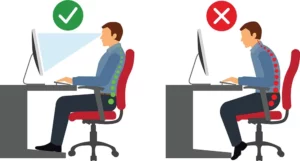 Want to straighten your back?
Want to straighten your back?
Everyone wants “excellent posture,” but keeping it is hard because doing the same things over and over again is stressful. Our bodies aren’t always able to get and keep good posture because of things like stress from working from home, sore muscles from the latest DIY project, long hours of slouching while playing video games with friends, and even the shoes we wear. They do everything they can to stop us from getting what we want.
If you want to keep your great posture, you’ll need more than a toy from the store. You need to be able to stand on one leg without falling over, have strong and flexible muscles, and be able to move all of your joints freely (especially your spine). This means that you shouldn’t just know the basics about your health, diet, and exercise; you should also be able to spot and fix bad posture and movement patterns in your daily life at work, at home, and on the road.
“Straight Back” Why is it important to have good posture?
Good posture is about more than just standing up straight and trying to look your best. It’s important to your health and well-being as a whole. Posture is just the position and alignment of the body, whether it is at rest or moving.
Adjusting Poor Posture
Dynamic posture is just the way our bodies stand while we move. We walk, run, lift, and bend with it. On the other hand, our body’s posture when it is at rest is called static posture. We sit, stand, and lay on it. It’s important to get and keep good static and moving posture because bad posture can have a direct effect on our bodies, both physically and mentally. Back pain is the most common problem that comes from bad posture, but that’s just the tip of the iceberg. Bad posture can also lead to or make:
- Backaches and neckaches
- Migraines and head aches
- Arthritis
- Digestion problems
- Problems with breathing
- Not enough flow
Good posture, like bad posture, can have a direct effect on our quality of life, but in a good way. Having good posture has many benefits, such as:
- Pain in the back and neck is less likely. Your balance and coordination are better.
- Higher energy levels
- lessened stress and worry
- Hope and a positive attitude
Adjusting Poor Posture To have good posture, you need a healthy spine. One of the most important parts of good posture is how your spine is positioned and how well your body can work.
As we get older, bad habits like slouching and being inactive make our muscles tired and tense, which in turn makes our posture worse. Most people think of back pain when they think of bad posture, but that’s just the tip of the iceberg. Maybe one of your shoulders is higher than the other or your pelvis is tilted. Over time, these kinds of imbalances can have a negative effect on the central nervous system. This can cause more serious problems, like pain in the neck and shoulders, headaches, and even scoliosis.
How to Stand Straight
Here are some things you can do right now to help your posture:
- Get up and move around. Simply getting up from your desk every hour and walking around the office can help your posture. This breaks the cycle of sitting for long periods of time and lowers the risk of back pain.
- Strengthen your core. Good posture is helped by strong core muscles, especially in the abs and lower back. Planks and bridges are good exercises to add to your routine to help build core strength.
- Pay attention to your posture when you’re sitting. Make sure your chair supports good posture by giving you enough lumbar support and letting your feet rest flat on the floor. To avoid neck strain, don’t cross your legs and make sure your computer screen is at eye level.
- Check your phone posture. Our phones have become an extension of our hands, and we often hold them in front of our faces for long periods of time. Make sure your phone is at eye level and stop scrolling every so often to avoid neck strain.
- Stand up straight with your shoulders back and down and your feet hip-width apart to improve your posture. Don’t stand still for too long, and move your weight from one foot to the other to keep your muscles from getting tired.
- Invest in good shoes. Good shoes can help you stand up straighter by giving your feet the right support and lowering the chance that you’ll have problems with your feet, ankles, or knees.
- Stretch often: Stretching regularly can help you become more flexible, ease muscle tension, and improve your posture. Simple stretches like the neck stretch, shoulder stretch, and low back stretch should be part of your daily routine.

